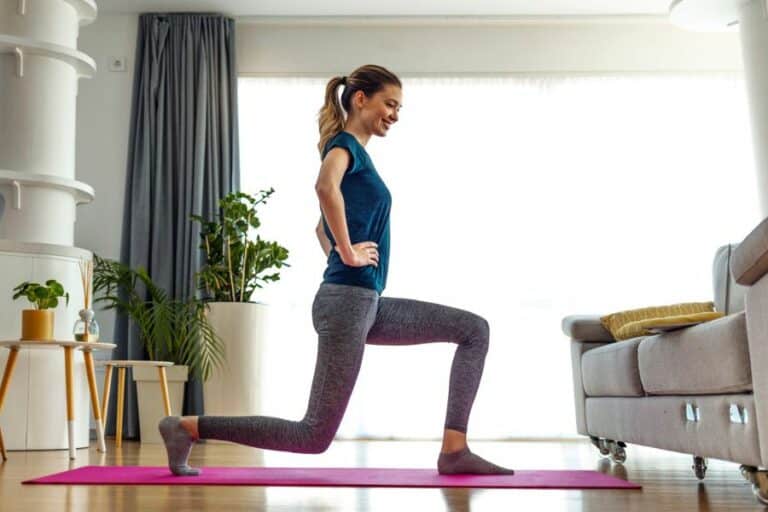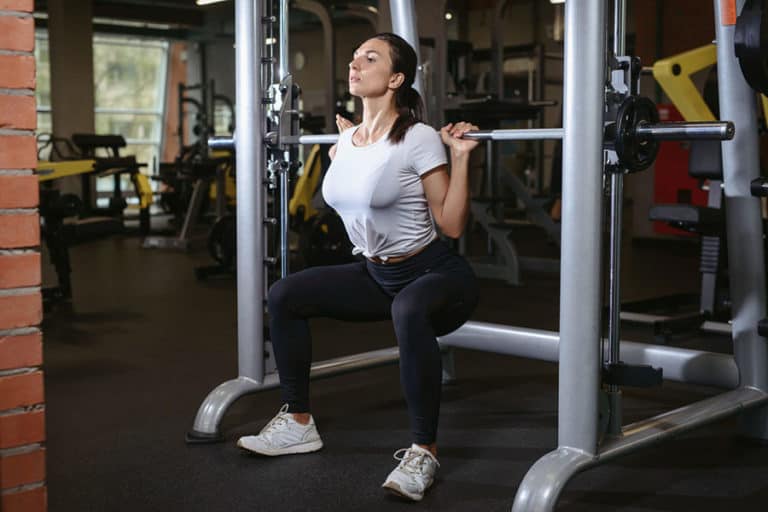13 Amazing Health Benefits of Squats

Benefits | How to do | Squat Workout Tips
Squats are a category of functional exercises loved and trusted by many. These exercises can power up your body to perform everyday tasks more efficiently. Discussed below are the many benefits of squats and how this exercise can improve your overall health.
Why should you do squats?
A ‘squat’ is the most fundamental movement of the human body. Squat workouts incorporate this move to strengthen the joints and muscles that are central to our day-to-day life and activities. You can easily power up your body with different squat variations, such as the basic squat, jump squat, back squat, box squat, overhead squat, and more.
Depending on the type of squats performed, this exercise may work some or all of the following muscles in your lower body:
- Quads
- Glutes
- Calves
- Adductors
- Hamstrings
- Core muscles
- Hip flexors
- Lower back
But the benefits of squats extend further. Let’s take a detailed look at the benefits below.
13 health benefits of squats
The benefits of squats range from improved lower body and core strength to convenience and ease of performance. Here is a list of 13 fundamental benefits of a squat workout:
1. Improves lower body strength
Squats are a type of compound exercise that target all the leg muscles, including your quadriceps, hamstrings, and calves. Performing squats regularly can help increase strength in these muscles. This leads to better performance in activities such as running and jumping.
2. Builds muscle
When you do resistance training like squats, it causes microscopic tears [1]University Hospitals: How Microtears Help You to Build Muscle Mass in your muscle tissue. As your body repairs these, your muscles grow larger and more robust. When you add weights to squat workouts, you put even more stress on your muscles. This leads to more muscle growth.
3. Improves core strength
One of the significant benefits of squats is that they help to improve core strength. When you squat, you engage your abdominal muscles and lower back muscles. This helps build strength in your core, leading to better balance and stability.
4. Improves flexibility
Squats require a good range of motion in the hips, knees, and ankles. Performing squats regularly automatically helps to increase the range of motion in these joints, making you more flexible.
5. Increased endurance
Adding squats to your workout can improve your body’s endurance over time. When you do squats regularly, your body becomes better at utilizing energy. This leads to increased muscle endurance. As a result, the body handles the impact of running and other activities much better.
6. Better heart health
Your heart rate increases while you perform squats, causing your blood to flow more rapidly to your muscles. This helps improve your cardiovascular fitness [2]Johns Hopkins Medicine: 3 Kinds of Exercise That Boost Heart Health and reduce your heart disease risk.
Performing a set of squats regularly has also been observed to lower the resting heart rate [3]PubMed: The effects of isometric wall squat exercise on heart rate and blood pressure in a normotensive population over time, resulting in better heart health.
7. Bone mineral density and joint health
Squats are the best exercises for anyone who needs to improve bone and joint health [4]Harvard Health Publishing: Strength training builds more than muscles .
Performing weighted squats put mechanical force on your bones, increasing the production of osteoblasts. These cells are central to the mineralization of the bones (thus preventing osteoporosis). Squat workouts also aid the absorption of calcium and other minerals into the bones and help to increase bone density.
Additionally, squats are one of the gentlest exercises for the joints when executed with proper form. They can improve joint health by lubricating the joints and increasing the blood flow to the muscles around them.
8. Prevents Injury
According to the American Council on Exercise [5]The American Council on Exercise: 5 Ways to Supercharge the Squat, adding squats to your workout prevents the risk of injury. Most injuries that happen to the body can be linked to postural imbalances and muscle weaknesses.
Squats strengthen your connective tissues, which support your joints. They also increase knee and hip stability, which in turn helps prevent a majority of problems caused by imbalances.
9. Improves posture
Squats target the core and lower back muscles. The core muscles are very important for postural health. Some of the most simple squats, like wall squats, can be quite beneficial for those who want to improve their posture.
10. Increased speed and mobility
Speed and mobility are benefits of squats that often get overlooked. When you do a lot of squats, your muscles adapt by becoming better at quickly contracting and relaxing. This leads to better speed and agility, which can come in handy in many sports and daily activities.
11. Keeps you functional
Squatting is perhaps the most elementary movement pattern in our life. Squat exercises utilize the basic functional movement patterns [6]National Library of Medicine: How to squat? Effects of various stance widths, foot placement angles and level of experience on knee, hip and trunk motion and loading to strengthen the muscles involved in the execution of most of our day-to-day activities.
These exercises help to improve your range of motion and flexibility, which helps to perform daily activities better. This helps to keep you functional as you age.
12. Higher calorie burn
The more muscle you have, the higher your metabolic rate. This is because muscle tissue is more active than fat tissue and consumes more energy. Doing squat exercises regularly can help to increase your muscle mass, leading to a higher metabolic rate and more fat burning.
13. It can be done anywhere
If you can’t hit the gym but want to intensify your exercise, try bodyweight squats. Most variations of squats don’t need fancy or expensive equipment and will still provide your body with a good workout.
Depending on your mood, and space availability, you can do squats anywhere, whether at the gym, at home, or even outdoors.
How to do a basic squat?
If the many benefits of squats have convinced you enough to add them to your workout routine, here’s a simple guide on how to do a basic squat:
- Start by standing with your feet shoulder-width apart and your hands at your sides.
- Keep your back straight, inhale, and engage your core.
- Lower your hips and bend your knees until your thighs are parallel to the ground.
- Pause for a moment, then slowly return to the starting position.
Tips to get the best out of your squat workouts
Below are some tips to help you get better at squat workouts. These will help you perform your squats more efficiently and effectively.
Firmly plant your feet on the ground
Planting your feet firmly on the ground ensures better distribution of your body weight. This is important for squatting with proper form by improving your balance and stability.
Maintain proper squat position
Maintaining a proper squat position is key to getting the most benefits from this exercise. Most squats require you to keep your feet shoulder-width apart and focus on the alignment of your spine to see the best results from your squat exercise routine.
Engage your core
Lack of core muscle activation can lead to bad squat position and lower back complications. Engaging your core helps to stabilize your body and improve your balance. This is important for getting the most benefits from your squat workout.
Pause at parallel
Squatting down to parallel is essential for getting the most benefits from this exercise. This ensures that all muscle groups work through a full range of motion, leading to better results.
Finish with an impression
Exhale and finish your squat by pressing through your heels and standing up tall. This will help to engage your core and glutes, and improve your balance.
Conclusion
In all of its variations, the dynamic squat exercise is a vital part of strength and resistance training programs. Regular squatting can boost calorie burn, strengthen your core, and benefit you in many other ways. However, consult a certified trainer before you start advanced squats.
References
| ↑1 | University Hospitals: How Microtears Help You to Build Muscle Mass |
|---|---|
| ↑2 | Johns Hopkins Medicine: 3 Kinds of Exercise That Boost Heart Health |
| ↑3 | PubMed: The effects of isometric wall squat exercise on heart rate and blood pressure in a normotensive population |
| ↑4 | Harvard Health Publishing: Strength training builds more than muscles |
| ↑5 | The American Council on Exercise: 5 Ways to Supercharge the Squat |
| ↑6 | National Library of Medicine: How to squat? Effects of various stance widths, foot placement angles and level of experience on knee, hip and trunk motion and loading |







